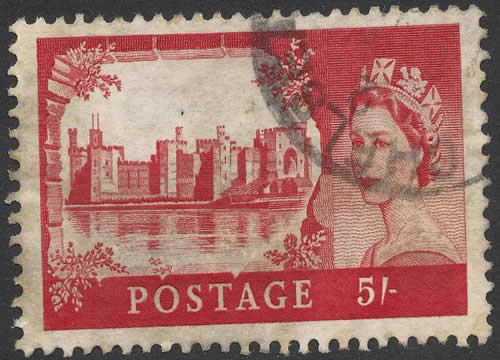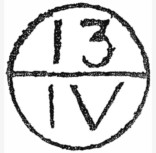
In 1661, one year into his tenure as England’s first appointed Postmaster General, Henry Bishop declared the invention of a new stamped mark to ensure prompt delivery of the mail. The seal would be affixed to each letter, “shewing the day of the moneth that every letter comes to this office, so that no letter Carryer may dare to detayne a letter from post to post.” This system was immediately adopted by the British Royal Mail, creating the world’s first stamped-mail service. “Bishop marks,” as these early stamps are called, featured a circle shape divided in two parts, with the upper half indicating the day and the lower half the month. The marks were used in various forms through 1787, when the British post began transitioning to stamps with more detailed information.

The postal system Bishop managed only delivered mail between the post offices of major towns, or “posts”; smaller localities and even some specific neighborhoods in large cities were left out. In 1680, the demand for local delivery in London and its suburbs inspired William Dockwra to open an independent postal service – the first “Penny Post”. Dockwra’s staff of couriers, rebels outside of the Royal Mail system, referred to themselves as “the undertakers.” They appointed hundreds of houses as receiver locations where letters could be left for collection every hour and then taken to larger distribution points. The delivery fees were one penny for letters traveling within the city, and two pence for those to the suburbs.

Like the Bishop system which was official under the Royal Mail, Dockwra also used a hand-stamp to verify paid postage. These stamps were triangular in shape and inscribed with the words “Penny Post Paid” and a single centered initial that indicated which collection office had taken payment. The British government’s postal monopoly shut down Dockwra’s service within two years, but continued operating a local “Penny Post” using a remarkably similar triangular stamp. Letters marked with Dockwra’s original stamps are extremely rare and highly valued today.
When Sir Rowland Hill (a teacher, inventor and social reformer who aimed to revamp the postal system) published a pamphlet calling for Post Office reform more than 100 years later in 1837, postage prices had gone up considerably, but the stamping system was basically unchanged. Hill’s criticisms focused on exorbitant fees, and his brochure was directed toward an official Commission of Inquiry that had been organized to investigate Royal Post Office mismanagement.

One of Hill’s proposals was prepaid postal stationery, including letter sheets, wrappers and envelopes, as well as smaller stamped “labels”, which he described as “bits of paper just large enough to bear the stamp, and covered at the back with a glutinous wash.” Hill also suggested that postage be uniformly charged by weight, rather than the existing system based on destination and pages per letter.
In the summer of 1839, a Parliamentary “Penny Postage” bill was passed; by May of the following year, Britain’s first adhesive stamps were printed. The first two stamps, known as the One Penny Black and Two Pence Blue, featured an engraved portrait of Queen Victoria with the word “POSTAGE” along the top edge and the denomination written along the bottom. Notably, the words “Great Britain” weren’t included anywhere on these first adhesive stamps, essentially because England was the only country in the world issuing paper stamps at the time. The omission became standard, and has been maintained on all official British postage since.
The one penny Penny Black was put on sale to the public in London on Friday, May 1, 1840, though it was not valid for use until Wednesday, May 6. A few are known to have been used before the sixth and these pre-official-first-day usages are very greatly prized by collectors. The Two Pence Blue was put on sale two days later on May 8, 1840. It is not widely known that the “labels” (the Penny Black and Two Pence Blue stamps) were considered by postal authorities a rather poor alternative to the prepaid 1d. and 2d. envelopes and letter sheets designed by a noted artist of the day, William Mulready, R.A., which were placed on sale at the same time (but that is another philatelic story).
Practically every stamp collector in the world wants to own a Great Britain 1840 Penny Black, Two Pence Blue or the 1841 Penny Red. But there is much more to the allure than the fact that they were the first postage stamps in the world. The design is simple and elegant with an image modeled on the William Wyon head of a young Queen Victoria and the legends “POSTAGE” at the top and “ONE PENNY” or “TWO PENCE” at the foot. The sides show an intricate engine-turned background.
While volumes have been written about the printing and plating history of the Penny Black, Two Pence Blue and Penny Red, no attempt will be made to present the depth of that topic here. It is enough to say that very comprehensive records and resources exist and are easily accessible to the average collector. With modern research methods, it is easy to determine such minutiae as when a particular scratch or wear appeared on what printing plate and the outcome of that to why the letter “O” is distorted in some of the stamps. At least one sizable volume exists containing information about only the cancellation marks, complete with illustrations.
The Penny Black was printed from eleven separate printing plates, each containing 240 impressions arranged in 20 horizontal rows of 12 which was important for Post Office accounting purposes. The stamp in the upper-left corner of the sheet had the letters AA in its lower corners, the next stamp was lettered AB then AC, AD and on to AL at the end of the row. The first stamp in the next row was BA, etc., down to the lower-right corner of the sheet which was lettered TL and was the last stamp on the plate. This was done to deter forgery as it was thought it would be difficult for a forger to be able to reproduce 240 different combinations of lettering and it would be noticed if quantities of mail bearing stamps with the same letters were found. Mathematically, each stamp within the official lettering system is equally rare and equally common.
The 240 impressions in each plate were produced from a single die that had blank lower corners. The die was rocked onto a steel plate 240 times and the corner letters were then hand-punched onto the plate. Inevitably, there are small differences in the positioning of these letters which, along with other plating aids, enables us to distinguish between the plates. The first plate (plate I) was rushed into use to meet the issue date for the stamps and was used before the steel had been hardened properly; this resulted in very rapid wear. Owing to the extreme wear, the engraved lines of the Queen’s head became very faint, and this required the restoration of every one of the 240 units of the plate before they had been used for even three months. Therefore, stamps from plate 1 are classified as either plate 1a (the original plate) or plate 1b (the re-entered plate).
The Penny Black and Two Pence Blue immediately proved to be very popular with the public despite the facts that they had to be cut from the sheets with a knife or scissor (perforations were still 10 years or more away) and the rather inconsistent gluey wash on the back had to be licked to adhere the stamp to the letter. The stamps were to be cancelled by a red postmark, in a design known the Maltese Cross. Some of the cancellation devices were damaged, lost or never received so alternate devices were used, resulting in what are known as “distinctive” Maltese Cross cancellations. Sometimes the cancellation was applied in a different colored ink such as blue, magenta, yellow or violet. After 1844, there would be countless cancellation devices with myriad different designs, some specific to a particular region of the United Kingdom.
Soon it was discovered that the red ink used for cancelling the black stamps could quite easily be cleaned off and there was a concern about stamps being used again. This was definitely not what the Royal Post wanted. In August, 1840 it was decided to change the color of the one-penny value from black to red, but printing of the stamps in the new color was delayed. Extensive experiments were conducted to find a new type of black ink for obliterating the stamps in order to prevent postmark removal and reuse of the stamps. Printing of the stamps in red began in late December, 1840 and the stamps came into use in early February, 1841. Therefore, the Penny Black had an active life of less than one year. Several of the original Penny Black plates were used to print the stamps in red. Curiously, because supplies of the black stamps were running low, additional printings were made in that color, even after the red printing had commenced.
Whereas the Penny Black was intended for use on mail weighing up to one-half ounce, the Two Pence Blue’s weight limit was a full ounce. The same printing plates were used for the Two Pence Blue and the design was identical to that of the Penny Black, varying only in its color and its cost, with “TWO PENCE” appearing beneath the image of Queen Victoria. When the decision was made to change the color of the Penny Black stamp to red, the ink used for the Two Pence Blue was also changed to prevent the cleaning and reusing of the stamps. At the same time, two new printing plates were made for the Two Pence Blue that included white lines below the word “POSTAGE” and above “TWO PENCE” to differentiate the new versions from the previous ones. These issues are generally referred to as the “white lines added issue”.
The Penny Red was sold until 1879, so vastly more of them were produced than either of the other stamps. However, they are still very old, very scarce and highly sought-after stamps. Throughout its 38-year life, the plates for the Penny Red were replaced many times over. The color in 1841 was a reddish-brown and was changed to lake-red in 1858. In 1854, stamp perforations were invented and were adopted at perforation 16. In 1855, the perforations were changed to 14 gauge as the sheets of 16 perforations came apart too easily when handled by postal clerks. Also in 1855, the watermark on the stamp paper was changed from a small crown to a large crown. The style of lettering in the corners was changed and letters began to be printed in all four corners of each stamp in 1858 with a new system of letter placement. Beginning in 1864, the plate number was engraved on each stamp, from Plate 71 going forward.
Of the three varieties of early Great Britain stamps discussed, the Two Pence Blue is considerably rarer than the Penny Black and immeasurably rarer than the Penny Red, which is reflected in its value today. Likewise, the Penny Black is considerably rarer than the Penny Red. In general, the Blue stamp will cost more than three times as much as the Black and up to five times more than the Red. Regardless of which stamp a collector buys first, it is unusual for any collector not to want all three of the Great Britain issue that were the first uniform postage stamps used in the world.
Stamp Collecting can be challenging and rewarding at the same time. Our job is to make you feel comfortable and prideful about your collections.
CONTACT USCopyright (c) MiniatureArtWorksUSA.com - All Rights Reserved.
